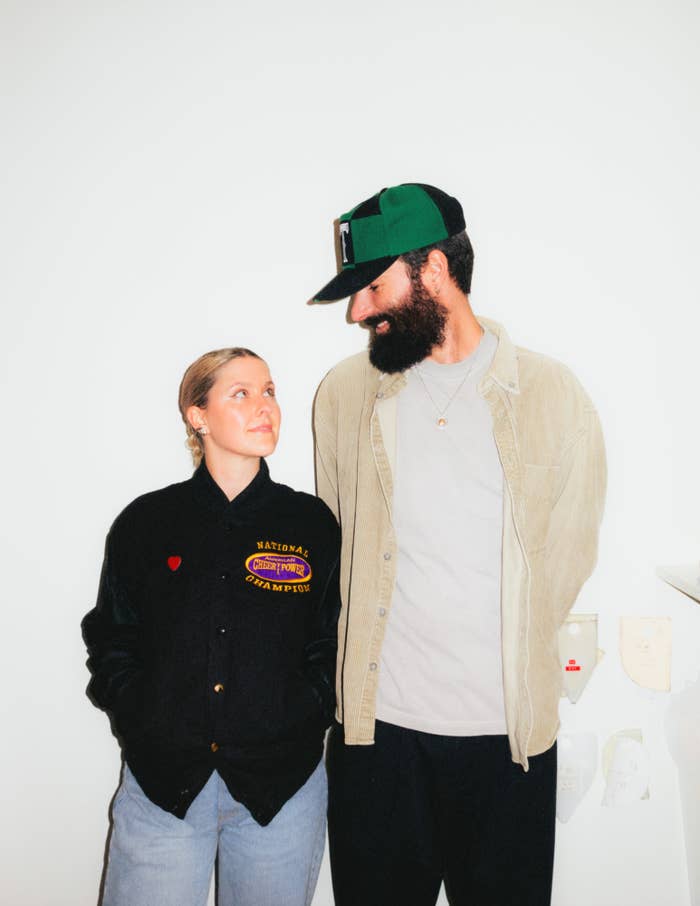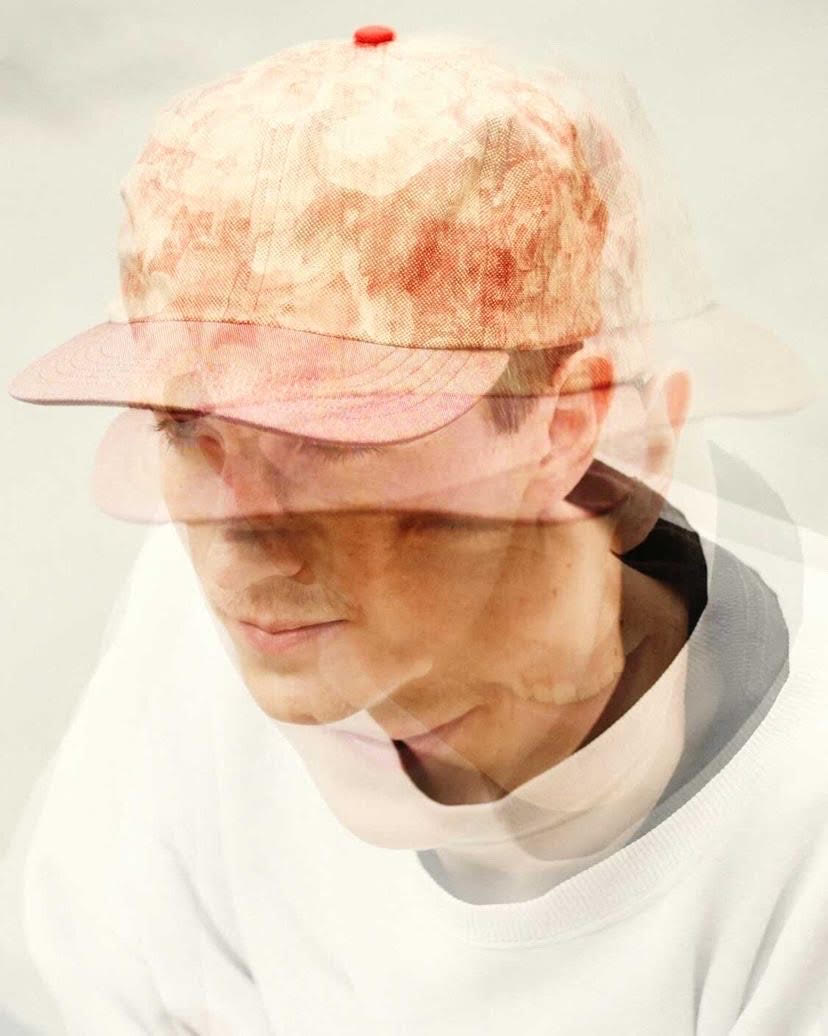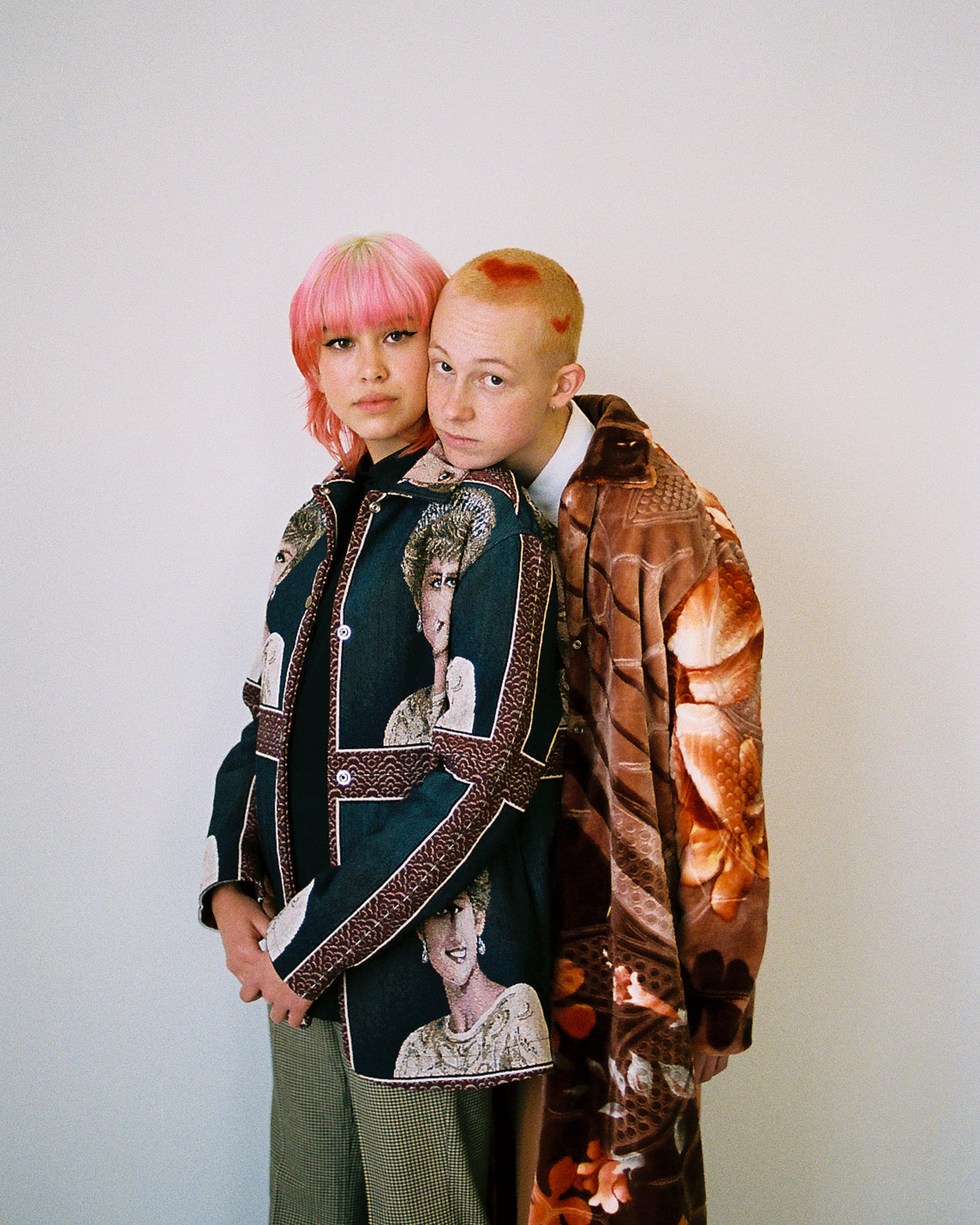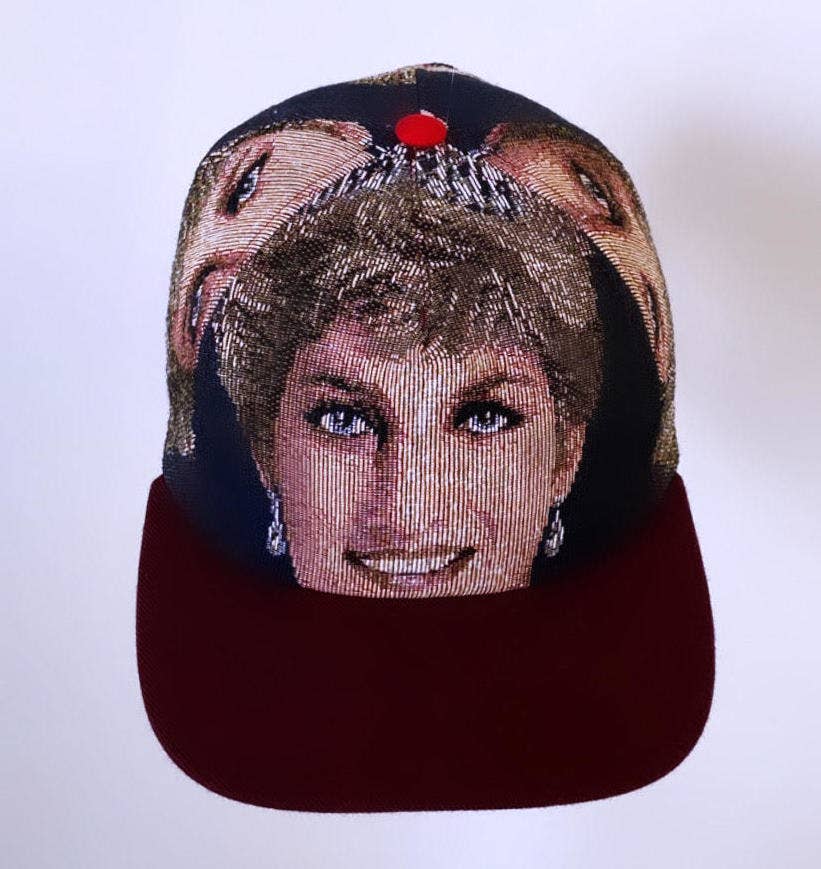
After navigating a series of public transit being either delayed, cancelled, or stuck in a record-breaking snowfall, I stand outside a warehouse slated for demolition in East Van, just outside of Vancouver’s downtown area. After a moment, Tom Robinson comes downstairs and lets me in.
This warehouse is the temporary home for a number of creatives including Robinson, and serves as the current headquarters for Thheme, Robinson’s brand of hats made entirely from upcycled materials. The studio is full of vintage hats and toys on display between shelves holding stacks of reclaimed, thrifted, and deadstock fabrics—everything Robinson needs to create his product. Inside the studio, we join his partner Jamie Dawes, the force behind Fyo͞ocher, creators of sustainable made-to-order women’s clothing popular among names like Ella Emhoff, Whitney Peak, and Chloe Wise.
Dawes and Robinson source their materials together, even occasionally creating items from the same roll, like a shirt and hat made from upholstery fabric featuring the face of Princess Diana. “Everything is sourced from [Facebook] marketplace, thrift stores, Craigslist, any factories that are selling end of roll, or even reaching out to people, and asking if they have scraps,” Robinson explains.
Though the couple have carved out their own individual niches in the world of sustainable fashion, Robinson gives full credit to his now fiancée, as the inspiration to start Thheme. After years working in the industry designing for other companies, Dawes quit her job to start Fyo͞ocher at the beginning of 2020. “There was nowhere that was sustainable to work for. It just didn’t really align with my values,” she explains. “There’s not really many small businesses who hire, so I just decided to start my own thing and try it out.”
What Dawes didn’t predict was the start of a pandemic just after quitting her job—since she had left her position in January, she didn’t qualify for any sort of financial assistance. But what came initially as a shock, turned out to be a blessing. “It was such a rare moment where we actually had time to just work all day or all night on creative projects,” says the 31-year-old designer.
Robinson worked as a signmaker by trade until he was laid off at the beginning of the pandemic. He had been wanting to quit his job for a while, he admits, noting the wastefulness of the signage industry. “Jamie starting Fyo͞ocher, and being like, ‘I wanna try and cut back on as much waste as possible,’ and I’m going up, slapping up a vinyl graphic for a bank, and ripping it down two weeks later, and throwing it in the garbage—and I’m like, ‘damn, okay, this is a bad look,” he laughs. With Fyo͞ocher already starting to take off, Robinson says he realized he wanted to start his own business. “I tried to go through the list of like, what are some things that there’s a hole in the market for… making pants? And Jamie was like, well you have so many hats, do people make hats?”

Just short of two years since the 33-year-old made his first hat by hand, Thheme hats have become ubiquitous in Vancouver amongst skateboarders, artists, and anyone with a mind for sustainable clothing. He has created hats for Vancouver’s Crack Gallery, and hosted a booth at House of Vans 2022 in Toronto as the only out of province vendor featured in the market.
Thheme and Fyo͞ocher talked to Complex Canada about the love of hats, sustainability, getting knocked off by fast fashion, and more.
When did you first become interested in clothing, and when did you decide that’s what you wanted to do for work?
Jamie: It kinda started in high school. I was really interested in my textile design and fashion classes that they offered there. In my last two years, they allowed me to take no other electives but fashion design, so I got to sew for like three hours a day, which was really nice. I always had a good understanding of sewing but had never done any pattern drafting, or anything other than sewing using commercial patterns before, until I went to university and literally got taught everything. That’s kind of how I was able to get work in the industry after, and it spiraled into this.
So at the beginning you were living and working together in the same space?
Jamie: We started in our apartment and it got way too full, so I moved back to Deep Cove in my childhood bedroom and had my studio there, and then as soon as I moved out, Tom took over the apartment, so it was literally the exact same chaos. Finally we were like, let’s get a studio together, and we moved into the Dominion building, just down in Gastown. We were there for a year, moved again, and then I finally just took over that whole space, and Tom moved into this spot.

How did you decide on hats?
Jamie: We were brainstorming, what are some things that you could start making, as a start-to-finish product. Accessories are a great avenue to take—it fits everyone, and Tom just loves hats. He has over 100 hats in our place, he wears a different one every day.
Tom: I feel like that’s where the name Thheme came into it—every hat is like a different theme for what you’re doing that day. It’s like, I’m gonna run the plaid hat, that’s my theme for today. There’s no rhyme or reason for me, especially… I respect people that wear the same fit all the time.
Jamie: And people are so particular with their hats. You can send him a hat, and he’ll make the exact fit that you want. I think that’s such a cool opportunity.
Tom: Especially for local people, coming by the studio and being able to dig through the fabrics. It’s kind of like offering a one-hour photo service—a one-hour hat. It’s something that I don’t really advertise as much as I should, but it’s there.

That’s something I’ve noticed—even though your hats don’t have a logo, you can tell it’s a Thheme hat if you see someone wearing one on the street.
Tom: That was kind of the plan to begin with. The hats that I really liked the fit of had giant logos on them. I want to have something simple that you can wear with everything. The red button for the top kind of ended up being the unintentional piece of branding… I had a bunch of red fabric, so I was like, okay, we’ll wrap them all in red, so that was kind of the thing. For the most part, the red button just seemed to work on all fabrics, but as I went on with business, y’know, if I’m making a black hat, you kinda want a black button on it. I just want the hat to be nice and the fit to be nice. I think that those elements of quality need to be checked off first. The branding doesn’t need to be the seller. I just want the product to be as good as it can be without cramming the sustainability aspect of it, or the handmade aspect, ‘cause first and foremost, this needs to be quality. And I think for both of us that rings true. We want it to be as good as it can be—and then you find out—oh it’s handmade? It’s using sustainable materials? That’s great!
Over the past year or so I’ve noticed a lot more people creating their own handmade and upcycled stuff. Do you feel like it’s become a larger trend lately?
Tom: For sure—2020, that year was the ultimate boom of starting a business with all this free time—which is sick.
Jamie: There are so many creators that came out of 2020, but a lot of those companies have kind of fallen off now, they went back to work.
Have you felt that being based in Canada has made it harder to get eyes on your products?
Tom: I think with social media shit, we have clientele in the most random spots, that I have no idea how people have found me, like some dudes in Michigan, and [other] random spots in the states. I think for the most part, Jamie ships a lot to the states, most of her clientele is in New York. People will find you. If the product is good, then it doesn’t matter.
I saw Ella Emhoff got a pair of your pants.
Jamie: Yeah. I was being carried by a store called Mall NYC and they did a photoshoot with her. After she posted in the pants I woke up to thousands of followers. That was the first time I understood like, what an influencer was, or what they can do. Like, that many people care about these pants? It was crazy.
And then you stopped selling them?
Jamie: They got completely knocked off by this Australian company, a big fast-fashion company. Like, to the tee. Even the S-Wave that I had done, and the mistakes that I had made, they copied those same mistakes. So it’s been kinda bad blood for me, those pants. I don’t wanna be making anything this fast fashion company is making as well. They can have it. It’s time to move on, I can do better.
Tom: We tried to light them up, it didn’t work.
Jamie: I sent some very stern emails. They said I was bullying them.

Was there a point after you guys started where you realized like, this is going to be your full-time job now, and that you won’t have to go back to working for someone else again?
Tom: I think I was too stubborn. I just decided right away. I was like, I don’t wanna work for anyone, and I want to try to run this for as long as I can, without having to get a job. For me, I think my attention needs to go fully into one thing. It’s hard to really put your attention into something when you’ve worked an eight-hour day, and you come home and just wanna chill, or go skate.
Jamie: I think right off the bat, we kind of had the determination to be like, ‘this is my job now.’ Having that sense of freedom working for yourself is a feeling like no other. So just kind of having that be the motivation. Like, ‘I will not let this fail, I’m not going to work for anyone else.’
Besides the obvious reasons for wanting to create clothing with sustainability in mind, why was it so important to you personally?
Jamie: I think sustainability has always been on my mind. I would never start a company without having that incorporated. I’ve always known that I want to make things, but I don’t want to add any more waste to our planet, so I’m just finding a way that we can run this company by using nothing new. It’s been a challenge, but I feel the most comfortable that way.
Tom: Nothing new should be produced for Fyo͞ocher or Thheme, just materials that already exist. We’re finding our own way to do it.

